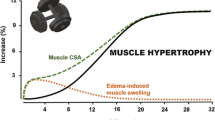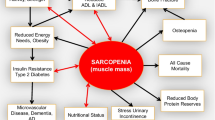Abstract
The phospholipid composition of membranes can influence the physiological functioning of the cell or subcellular organelle. This association has been previously demonstrated in skeletal muscle, where cellular or subcellular membrane, specifically mitochondria, phospholipid composition is linked to muscle function. However, these observations are based on whole mixed skeletal muscle analysis, with little information on skeletal muscles of differing fiber-type compositions. These past approaches that used mixed muscle may have misidentified outcomes or masked differences. Thus, the purpose of this study was to compare the phospholipid fatty acid composition of subsarcolemmal (SS) mitochondria isolated from slow-twitch postural (soleus), fast-twitch highly oxidative glycolytic locomotory (red gastrocnemius), and fast-twitch oxidative glycolytic locomotory (plantaris) skeletal muscles. The main findings of the study demonstrated unique differences between SS mitochondrial membranes from postural soleus compared to the other locomotory skeletal muscles examined, specifically lower percentage mole fraction of phosphatidylcholine (PC) and significantly higher percentage mole fraction of saturated fatty acids (SFA) and lower n6 polyunsaturated fatty acids (PUFA), resulting in a lower unsaturation index. We also found that although there was no difference in the percentage mole fraction of cardiolipin (CL) between skeletal muscle types examined, CL of soleus mitochondrial membranes were approximately twofold more SFA and approximately two-thirds less PUFA, resulting in a 20–30% lower unsaturation and peroxidation indices. Thus, the results of this study indicate unique membrane lipid composition of mitochondria isolated from different skeletal muscle types, a potential consequence of their respective duty cycles.



Similar content being viewed by others
References
Armstrong RB, Laughlin MH (1985) Metabolic indicators of fibre recruitment in mammalian muscles during locomotion. J Exp Biol 115:201–213
Baldwin KM, Klinkerfuss GH, Terjung RL, Mole PA, Holloszy JO (1972) Respiratory capacity of white, red, and intermediate muscle: adaptative response to exercise. Am J Physiol 222:373–378
Benton CR, Campbell SE, Tonouchi M, Hatta H, Bonen A (2004) Monocarboxylate transporters in subsarcolemmal and intermyofibrillar mitochondria. Biochem Biophys Res Comm 323:249–253
Blackard WG, Li J, Clore JN, Rizzo WB (1997) Phospholipid fatty acid composition in type I and type II rat muscle. Lipids 32:193–198
Bradley NS, Heigenhauser GJF, Roy BD, Staples EM, Inglis JG, LeBlanc PJ, Peters SJ (2008) The acute effects of differential dietary fatty acids on human skeletal muscle pyruvate dehydrogenase activity. J Appl Physiol 104:1–9
Brand MD (2005) The efficiency and plasticity of mitochondrial energy transduction. Biochem Soc Trans 33:897–904
Brand MD, Esteves TC (2005) Physiological functions of the mitochondrial uncoupling proteins UCP2 and UCP3. Cell Metab 2:85–93
Brand MD, Pamplona R, Portero-Otin M, Requena JR, Roebuck SJ, Buckingham JA, Clapham JC, Cadenas S (2002) Oxidative damage and phospholipid fatty acyl composition in skeletal muscle mitochondria from mice underexpressing and overexpressing uncoupling protein 3. Biochem J 368:597–603
Cadenas E, Davies KJ (2000) Mitochondrial free radical generation, oxidative stress, and aging. Free Rad Biol Med 29:222–230
Claypool SM (2009) Cardiolipin, a critical determinant of mitochondrial carrier protein assembly and function. Biochim Biophys Acta 1788:2059–2068
Cullis PR, de Kruijff B (1979) Lipid polymorphism and the functional roles of lipids in biological membranes. Biochim Biophys Acta 559:399–420
Daum G (1985) Lipids of mitochondria. Biochim Biophys Acta 822:1–42
Delp MD, Duan C (1996) Composition and size of type I, IIA, IID/X, and IIB fibers and citrate synthase activity of rat muscle. J Appl Physiol 80:261–270
Echtay KS, Pakay JL, Esteves TC, Brand MD (2005) Hydroxynonenal and uncoupling proteins: a model for protection against oxidative damage. BioFactors 24:119–130
Faulks SC, Turner N, Else PL, Hulbert AJ (2006) Calorie restriction in mice: effects on body composition, daily activity, metabolic rate, mitochondrial reactive oxygen species production, and membrane fatty acid composition. J Gerontol A Biol Sci Med Sci 61:781–794
Fiehn W, Peter JB, Mead JF, Gan-Elepano M (1971) Lipids and fatty acids of sarcolemma, sarcoplasmic reticulum, and mitochondria from rat skeletal muscle. J Biol Chem 246:5617–5620
Folch J, Lees M, Stanley GHS (1957) A simple method for the isolation and purification of total lipides from animal tissues. J Biol Chem 226:497–509
Hong H-Y, Yoo G-S, Choi J-K (2000) Direct blue 71 staining of proteins bound to blotting membranes. Electrophoresis 21:841–845
Hood DA (2001) Plasticity in skeletal, cardiac, and smooth muscle invited review: contractile activity-induced mitochondrial biogenesis in skeletal muscle. J Appl Physiol 90:1137–1157
Hulbert AJ (2005) On the importance of fatty acid composition of membranes for aging. J Theor Biol 234:277–288
Hulbert AJ, Turner N, Hinde J, Else PL, Guderley H (2006) How might you compare mitochondria from different tissues and different species? J Comp Physiol 176(B):93–105
Klingenberg M (2009) Cardiolipin and mitochondrial carriers. Biochim Biophys Acta 1788:2048–2058
Kraffe E, Marty Y, Guderley H (2007) Changes in mitochondrial oxidative capacities during thermal acclimation of rainbow trout Oncorhynchus mykiss: roles of membrane proteins, phospholipids and their fatty acid compositions. J Exp Biol 210:149–165
Kriketos AD, Pan DA, Sutton JR, Hoh JF, Baur LA, Cooney GJ, Jenkins AB, Storlien LH (1995) Relationships between muscle membrane lipids, fiber type, and enzyme activities in sedentary and exercised rats. Am J Physiol 269:R1154–R1162
Ladbrooke BD, Chapman D (1969) Thermal analysis of lipids, proteins and biological membranes. A review and summary of some recent studies. Chem Phys Lipids 3:304–356
Leary SC, Lyons CN, Rosenberger AG, Ballantyne JS, Stillman J, Moyes CD (2003) Fiber-type differences in muscle mitochondrial profiles. Am J Physiol 285:R817–R826
LeBlanc PJ, Harris RA, Peters SJ (2007) Skeletal muscle fiber type comparison of pyruvate dehydrogenase phosphatase activity and isoform expression in fed and food-deprived rats. Am J Physiol 292:E571–E576
LeBlanc PJ, Mulligan M, Antolic A, MacPherson L, Inglis JG, Martin D, Roy BD, Peters SJ (2008) Skeletal muscle type comparison of pyruvate dehydrogenase phosphatase activity and isoform expression: effects of obesity and endurance training. Am J Physiol 295:R1224–R1230
Lee AG (2004) How lipids affect the activities of integral membrane proteins. Biochim Biophys Acta 1666:62–87
Mahadevappa VG, Holub BJ (1987) Quantitative loss of individual eicosapentaenoyl-relative to arachidonoyl-containing phospholipids in thrombin-stimulated human platelets. J Lipid Res 28:1275–1280
Makinen MW, Lee C-P (1968) Biochemical studies of skeletal muscle mitochondria. I. Microanalysis of cytochrome content, oxidative and phophorylative activities of mammalian skeletal muscle mitochondria. Arch Biochem Biophys 126:75–82
McIntosh TJ, Simon SA (2006) Roles of bilayer material properties in function and distribution of membrane proteins. Ann Rev Biophys Biomol Struct 35:177–198
Ogata T, Yamasaki Y (1985) Scanning electron-microscopic studies on the three-dimensional structure of mitochondria in the mammalian red, white and intermediate muscle fibers. Cell Tissue Res 241:251–256
Ott M, Zhivotovsky B, Orrenius S (2007) Role of cardiolipin in cytochrome c release from mitochondria. Cell Death Diff 14:1243–1247
Peters SJ, Harris RA, Heigenhauser GJF, Spriet LL (2001) Muscle fiber type comparison of PDH kinase activity and isoform expression in fed and fasted rats. Am J Physiol 280:R661–R668
Peuchant E, Salles C, Vallot C, Wone C, Jensen R (1988) Increase of erythrocyte resistance to hemolysis and modification of membrane lipids induced by hemodialysis. Clinica Chimica Acta 178:271–282
Sachdev S, Davies KJ (2008) Production, detection, and adaptive responses to free radicals in exercise. Free Rad Biol Med 44:215–223
Schlame M, Rua D, Greenberg ML (2000) The biosynthesis and functional role of cardiolipin. Prog Lipid Res 39:257–288
Schlame M, Ren M, Xu Y, Greenberg ML, Haller I (2005) Molecular symmetry in mitochondrial cardiolipins. Chem Phys Lipids 138:38–49
Skulachev VP (2001) Mitochondrial filaments and clusters as intracellular power-transmitting cables. Trends Biochem Sci 26:23–29
Stuart JA, Cadenas S, Jekabsons MB, Roussel D, Brand MD (2001) Mitochondrial proton leak and the uncoupling protein 1 homologues. Biochim Biophys Acta 1504:144–158
Tsalouhidou S, Argyrou C, Theofilidis G, Karaoglanidis D, Orfanidou E, Nikolaidis MG, Petridou A, Mougios V (2006) Mitochondrial phospholipids of rat skeletal muscle are less polyunsaturated than whole tissue phospholipids: implications for protection against oxidative stress. J Anim Sci 84:2818–2825
Victor T, van der Merwe N, Benade AJS, La Cock C, Lochner A (1985) Mitochondrial phospholipid composition and microviscosity in myocardial ischaemia. Biochim Biophys Acta 834:215–223
Wicks KL, Hood DA (1991) Mitochondrial adaptations in denervated muscle: relationship to muscle performance. Am J Physiol 260:C841–C850
Yamaoka S, Urade R, Kito M (1988) Mitochondrial function in rats is affected by modification of membrane phospholipids with dietary sardine oil. J Nutr 118:290–296
Acknowledgments
This study was supported by the Natural Sciences and Engineering Research Council of Canada (PJL, SJP, and BDR). LES was supported by a Master’s Graduate Training Award from the Canadian Institutes of Health Research.
Author information
Authors and Affiliations
Corresponding author
Rights and permissions
About this article
Cite this article
Stefanyk, L.E., Coverdale, N., Roy, B.D. et al. Skeletal Muscle Type Comparison of Subsarcolemmal Mitochondrial Membrane Phospholipid Fatty Acid Composition in Rat. J Membrane Biol 234, 207–215 (2010). https://doi.org/10.1007/s00232-010-9247-4
Received:
Accepted:
Published:
Issue Date:
DOI: https://doi.org/10.1007/s00232-010-9247-4




